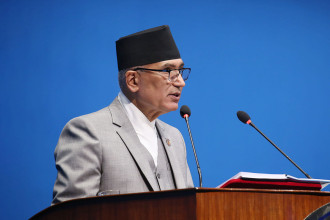
Nepal is aiming for self-reliance in multiple sectors from 2020 under the joint initiative of the government and the private sector with an aim to generate jobs, boost production, spur growth, minimise the burgeoning trade deficit and increase foreign exchange earnings. We look at key areas under debate.
HYDROELECTRICITY
The major area of self-reliance in 2020 is hydro-electricity generation. Nepal faced rolling blackouts for almost a decade which ended just three years back. Nepal has started to generate sufficient electricity for summer, however electricity generation goes down by almost one third of the installed capacity from the snow-fed run-of-the-river (RoR) projects during winter.
According to Prabal Adhikari, spokesperson of the Nepal Electricity Authority (NEA), an additional 1000 MW of electricity will be added to the national grid in 2020. Currently, the country’s total hydro-electricity generation capacity hovers at 1270 MW. NEA and Independent Power Producers are generating equal quantum of electricity at 635 MW each. Nepal opened up private sector investment in hydroelectricity generation in mid 1990s.
In winter, peak electricity demand surges to 1300 MW. To bridge the gap between demand and domestic production, NEA imports 350 to 400 MW of electricity from India. Electricity import bill of NEA from India stands at Rs 17 billion per annum and this is expected to reduce from 2020.
Self-reliance in hydroelectricity generation will not only bring down electricity import bill but also reduce the use of fossil-fuel. NEA has proposed subsidy in induction heaters from 2020. There has also been debate in revision of current tariff policy to encourage use of electricity. According to experts, availability of reliable and affordable supply of hydroelectricity will prompt people to switch to green-transportation and attract industrialists to invest and boost industrial production.
CEMENT AND CLINKER
The government had announced making the country self-reliant in some industrial products including cement from the fiscal budget of 2018-19. Other areas are sugar, footwear and pharmaceuticals. Clinker import in recent years is insignificant. According to Engineer Dhruva Raj Thapa, President of Cement Manufacturers Association of Nepal, 21 cement factories have their own lime stone mines and are producing clinker themselves. There are altogether 61 cement factories in the country. The clinker producing factories supply clinker to other factories as well. In the last fiscal, demand for cement stood at 10 million tons. However, cement factories in Nepal have the capacity to produce 15 million tons in a year. According to Thapa, Nepali cement factories are able to produce high quality OPC (Ordinary Portland Cement) and PPC (Portland Pozzolana Cement).
The Cement Manufacturers Association of Nepal states that the capacity of cement factories is set to double the demand in one and a half years. “In the next one and a half years, demand of cement will surge by 12.5 million tons and production capacity of cement factories will be 25 million tons.”
The government has encouraged private sector investment in cement by various measures including electricity, road connectivity, etc. This has lured private and foreign investors to create high capacity cement plants such as Hongshi and Arghakhachi. Similar capacity cement factories called Palpa Cement and Huaxin are set to begin production in 2020.
FOOTWEAR
Though footwear has huge potential, Nepal still relies on raw material imports for production. Some footwear manufacturers such as Kiran Shoes (Goldstar) have however been exporting their products successfully. Baikuntha Aryal, Secretary of the Ministry of Industry, Commerce and Supplies has said that the government has been studying how best they can support the footwear industry, cement and poultry, areas that are recognised to have competitive and comparative advantage.
POTENTIAL AREAS
The government has envisioned self reliance in production of sugar and even slapped 30% duty on its import. However, domestic sugar producers are unable to clear their stocks. Six sugar mills have yet to clear outstanding dues worth Rs 1.33 billion of cane growers who have staged protests in capital citing that the sugar mill owners have yet to clear past dues while crushing season of this year has already started. There are a dozen sugar mills in operation in the country. The government has said that it cannot adopt protectionist measures over a long time to save under-competitive industries. The government has also adopted a policy to incentivise and safeguard sugarcane farmers by fixing the support price every year. But will these measures be enough? Sugar mills argue that the price of sugarcane is high in Nepal due to lack of incentives for farmers resulting in high cost of raw material. They also argue that the global fall in the price of sugar last year hit the industry hard.
Experts criticise Nepal’s over dependence on agro product imports despite the country being an agrarian economy with almost 55% of the population engaged in agriculture.
According to economist Pushkar Bajracharya, who served as member of the National Planning Commission (NPC), Nepal has been importing 600,000 tons of cereals annually and it is expected to rise to 800,000 tons in 2020. Similarly, there is short fall of the production of 300,000 liters milk, 500,000 tons meat, 600,000 tons of vegetables compared to the demand. The government must work towards increasing the production to bridge the gap between exports and imports. This would contribute in inclusive development of the economy as 61% of the total population engaged in agriculture is female. He asked the government to come up with concrete action plans to make the country self-reliant in key potential areas.


-1758006240.jpg)
-1752225714.jpg)

